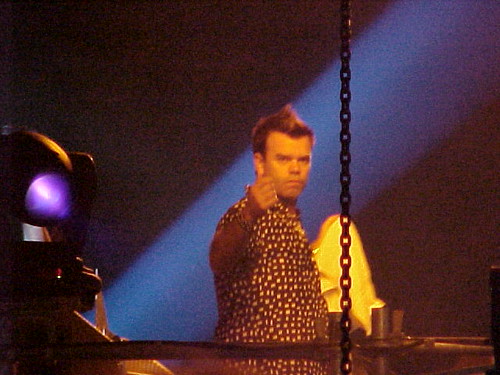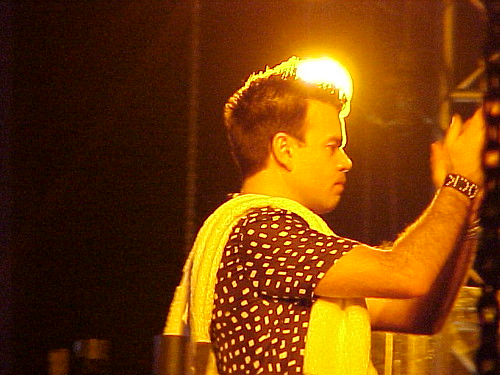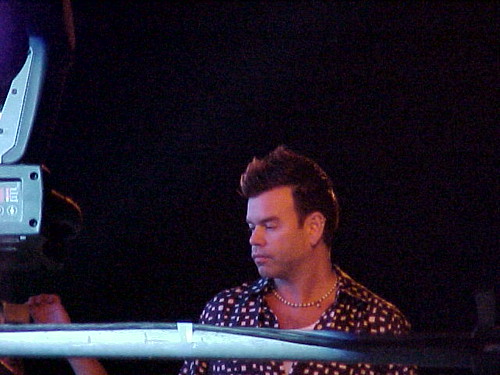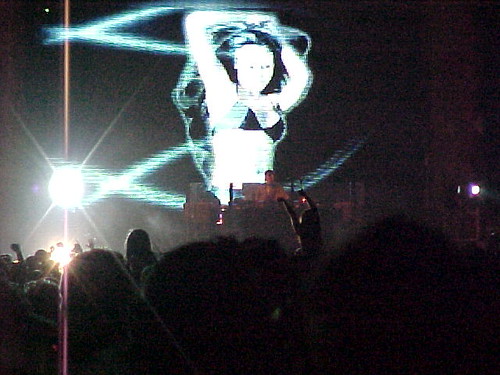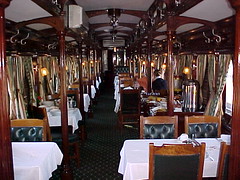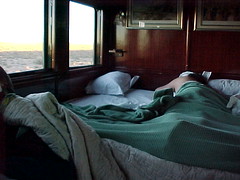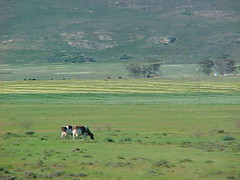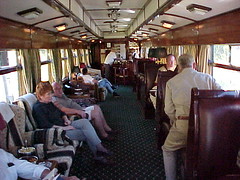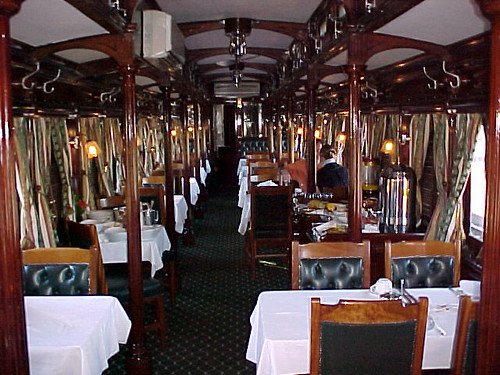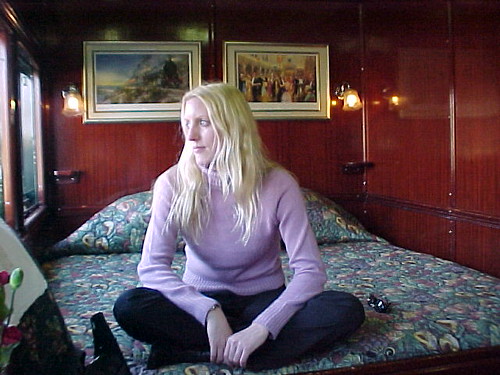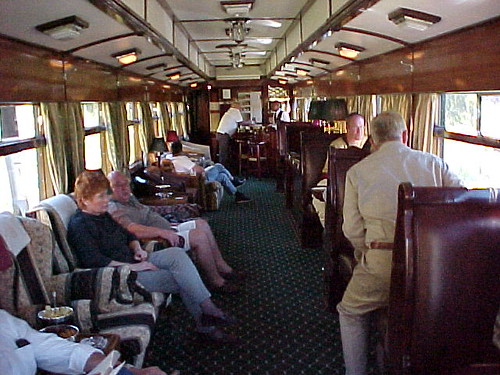Tuesday 28 August 2001
Paul Oakenfold thumbs up!
An extract from Paul Oakenfold: The Authorised Biography by Richard Norris, we recount a memorable free gig at the height of Paul's popularity as a DJ...
Having quit his residency at Cream for the ill-fated Home club in London's Leicester Square, Paul was left without a regular gig and was increasingly looking towards breaking America as his next challenge.
He had pretty much created the concept of the superstar DJ and knew it would work in the States if he put in enough hard graft. Meanwhile his status in the UK couldn't have been bigger, as proved one hot summer's night in London...
Paul Oakenfold thumbs up!
An extract from Paul Oakenfold: The Authorised Biography by Richard Norris, we recount a memorable free gig at the height of Paul's popularity as a DJ...
Having quit his residency at Cream for the ill-fated Home club in London's Leicester Square, Paul was left without a regular gig and was increasingly looking towards breaking America as his next challenge.
He had pretty much created the concept of the superstar DJ and knew it would work in the States if he put in enough hard graft. Meanwhile his status in the UK couldn't have been bigger, as proved one hot summer's night in London...
Monday 27 August 2001
Paul Oakenfold plays Clapham Common
He had pretty much created the concept of the superstar DJ and knew it would work in the States if he put in enough hard graft. Meanwhile his status in the UK couldn't have been bigger, as proved one hot summer's night in London. An extract from Paul Oakenfold: The Authorised Biography by Richard Norris, we recount a memorable free gig at the height of Paul's popularity as a DJ.
“It was f***ing phenomenal,” says Marc Marot. “It was one of the most gobsmacking moments. Channel 4 were completely caught on the hop. By the time there were seventy thousand people there, this supposedly giant screen they’d put up looked like a telly. Paul’s playing to a crowd the size of Glastonbury, and there’s this little screen with a DJ set-up beside it with a small sound system. It was a riot.”
Paul Oakenfold plays Clapham Common
He had pretty much created the concept of the superstar DJ and knew it would work in the States if he put in enough hard graft. Meanwhile his status in the UK couldn't have been bigger, as proved one hot summer's night in London. An extract from Paul Oakenfold: The Authorised Biography by Richard Norris, we recount a memorable free gig at the height of Paul's popularity as a DJ.
“It was f***ing phenomenal,” says Marc Marot. “It was one of the most gobsmacking moments. Channel 4 were completely caught on the hop. By the time there were seventy thousand people there, this supposedly giant screen they’d put up looked like a telly. Paul’s playing to a crowd the size of Glastonbury, and there’s this little screen with a DJ set-up beside it with a small sound system. It was a riot.”
Sunday 26 August 2001
Paul Oakenfold plays Clapham Common
“I played Wembley Stadium opening for U2, but the Clapham Common gig was arguably my biggest ever gig in London,” says Paul.
“This was my gig, and it was free. No one in their right mind expected what went on. It was meant to be people sitting watching the cricket, with a bit of a party after. I was thinking, ‘it’s a nice day, we’ll get maybe ten thousand,’ but the build-up was massive – they changed the advertising, so all over London I had these big billboard posters sup. It became not just a South London event, it became a massive free party for the whole city. The people just didn’t stop coming.”
Things go a bit out of hand at the end, however. Channel 4 had told the Clapham residents that they’d pull the plug at eight, pretty early for an outdoor gig.
“The moment they put the Channel 4 logo on to end the show, bottles and cans started flying, says Marc Marot. “Unfortunately the hospitality area was directly behind the screen – we had to hide while vodka bottles were thumping on the roof, whacking into Channel 4 executives’ cars! It was like Beirut!”
Paul Oakenfold plays Clapham Common
“I played Wembley Stadium opening for U2, but the Clapham Common gig was arguably my biggest ever gig in London,” says Paul.
“This was my gig, and it was free. No one in their right mind expected what went on. It was meant to be people sitting watching the cricket, with a bit of a party after. I was thinking, ‘it’s a nice day, we’ll get maybe ten thousand,’ but the build-up was massive – they changed the advertising, so all over London I had these big billboard posters sup. It became not just a South London event, it became a massive free party for the whole city. The people just didn’t stop coming.”
Things go a bit out of hand at the end, however. Channel 4 had told the Clapham residents that they’d pull the plug at eight, pretty early for an outdoor gig.
“The moment they put the Channel 4 logo on to end the show, bottles and cans started flying, says Marc Marot. “Unfortunately the hospitality area was directly behind the screen – we had to hide while vodka bottles were thumping on the roof, whacking into Channel 4 executives’ cars! It was like Beirut!”
Saturday 25 August 2001
Paul Oakenfold plays Clapham Common
An extract from Paul Oakenfold: The Authorised Biography by Richard Norris, we recount a memorable free gig at the height of Paul's popularity as a DJ...
The channel had just acquired the rights to show the Ashes, cricket’s main draw, from the BBC, and wanted to celebrate in style. The mounted a huge campaign in London promoting the fact, and announced that they would put up a huge screen in Clapham Common for the first England v Australia showdown.
Paul had a friend at Channel 4’s marketing department, who managed to book the DJ to play after the cricket for free, as a favour.
There was only one problem. In the run-up to the event, England managed to lose the cricket series; it was pretty much over by the time the match reached Clapham Common.
Channel 4 had made a commitment to screen the match, and had taken out advertising space all over town. The billboards were changed accordingly – instead of promoting he cricket on the big screen, Channel 4 now elevated Paul’s DJ set to top of the bill.
There was a food stand, a reasonable sized DJ arena, a few toilets, a couple of policemen and a dog. A handful of security guards loitered round the front of the DJ booth.
Everybody was expecting a couple of thousand people to take advantage of this warm summer’s day, leisurely pitching up for some nice tunes in the park. Big mistake. According to the police count, around seventy thousand people turned up.
Paul Oakenfold plays Clapham Common
An extract from Paul Oakenfold: The Authorised Biography by Richard Norris, we recount a memorable free gig at the height of Paul's popularity as a DJ...
The channel had just acquired the rights to show the Ashes, cricket’s main draw, from the BBC, and wanted to celebrate in style. The mounted a huge campaign in London promoting the fact, and announced that they would put up a huge screen in Clapham Common for the first England v Australia showdown.
Paul had a friend at Channel 4’s marketing department, who managed to book the DJ to play after the cricket for free, as a favour.
There was only one problem. In the run-up to the event, England managed to lose the cricket series; it was pretty much over by the time the match reached Clapham Common.
Channel 4 had made a commitment to screen the match, and had taken out advertising space all over town. The billboards were changed accordingly – instead of promoting he cricket on the big screen, Channel 4 now elevated Paul’s DJ set to top of the bill.
There was a food stand, a reasonable sized DJ arena, a few toilets, a couple of policemen and a dog. A handful of security guards loitered round the front of the DJ booth.
Everybody was expecting a couple of thousand people to take advantage of this warm summer’s day, leisurely pitching up for some nice tunes in the park. Big mistake. According to the police count, around seventy thousand people turned up.
Friday 24 August 2001
Notting Hill Carnival - 2001
The current route for the main parade covers around 3 miles, following Great Western Road, Chepstow Road, Westbourne Grove and Ladbroke Grove. In addition to trucks with pan bands or mobile sound systems, there are costumed masqueraders and around 40 static sound systems spread throughout the area playing a range of music at high volume. While the "traditional" Soca and some Calypso can still be found, many other musical styles are represented.
The Notting Hill Carnival actually began in St Pancras and moved around until it found its home. From town halls it has now grown to a huge event, which last year led the Jubilee procession down the Mall.
The Carnival's roots date back to the Abolition of Slavery Act in 1833 when the first Caribbean carnival was held in Trinidad.
Black Caribbeans took to the streets for their own carnival party, with song, dance and costumes.
Notting Hill Carnival - 2001
The 2001Carnival kicks off on Saturday with the Panorama, a competition between steelpan bands mainly from London but more recently including some bands from other areas of the UK. Sunday is Children's Day, with a shorter Carnival route for children and young people. The main parade then takes place on Monday.
The current route for the main parade covers around 3 miles, following Great Western Road, Chepstow Road, Westbourne Grove and Ladbroke Grove. In addition to trucks with pan bands or mobile sound systems, there are costumed masqueraders and around 40 static sound systems spread throughout the area playing a range of music at high volume. While the "traditional" Soca and some Calypso can still be found, many other musical styles are represented.
The Notting Hill Carnival actually began in St Pancras and moved around until it found its home. From town halls it has now grown to a huge event, which last year led the Jubilee procession down the Mall.
The Carnival's roots date back to the Abolition of Slavery Act in 1833 when the first Caribbean carnival was held in Trinidad.
Black Caribbeans took to the streets for their own carnival party, with song, dance and costumes.
Friday 17 August 2001
Rovos Rail the most luxurious train in the world, South Africa
 Since its establishment in 1989, Rovos Rail has earned an international reputation for its truly world class travel experiences. Step aboard the wood panelled coaches - classics remodelled and refurbished to mint condition - and enjoy fine cuisine in five-star luxury as some of the most varied scenery imaginable unfolds beyond the windows.
Since its establishment in 1989, Rovos Rail has earned an international reputation for its truly world class travel experiences. Step aboard the wood panelled coaches - classics remodelled and refurbished to mint condition - and enjoy fine cuisine in five-star luxury as some of the most varied scenery imaginable unfolds beyond the windows.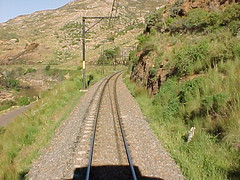
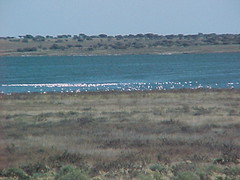

View from the Observation car of The Pride of Africa, Flamingos on Kamfers Lake, Kimberley, The Big Hole Kimberley
There's an accent on fresh local ingredients, and traditional dishes such as game are a specialty. Every morning there's a full breakfast with dishes cooked to order. A selection of cold meats, croissants, pastries, fresh fruit, yoghurts, cereals and preserves make up a tempting breakfast buffet.
Green fields outside Cape Town, Observation Car Rovos Rail
Rovos Rail, Dining car
Since its establishment in 1989, Rovos Rail has earned an international reputation for its truly world class travel experiences. Step aboard the wood panelled coaches - classics remodelled and refurbished to mint condition - and enjoy fine cuisine in five-star luxury as some of the most varied scenery imaginable unfolds beyond the windows. Recapture the romance and atmosphere of a bygone era, when privileged travellers experienced the magic and mystery of Africa in a relaxed and elegant fashion.The trains - which may be hauled by steam, diesel or electric locomotives at various stages of the journey - carry a maximum of 72 passengers in 36 superbly appointed suites. Pride of place in the Rovos stable goes to the historic and newly rebuilt Capital Park Station and locomotive yard, which is the heart and new headquarters of this private railway company. .
The coaches have been painstakingly rebuilt and the use fine wood panelling, traditional furnishings and period décor has ensured an atmosphere of elegance and grandeur. Exquisite pillared dining cars are a signature of the Rovos Rail trains. Each one has a proud history and has been meticulously restored from a derelict state. For example Dining Car No 195 ‘ Shangani ‘, which was built in 1924, was found parked in a siding in Alberton near Johannesburg before its acquisition by Rohan Vos in 1986. Three of the magnificent teak pillars had been removed and these were faithfully crafted, restoring the Victorian atmosphere. Each of the trains has two 42-seater dining cars to accommodate the maximum complement of 72 passengers in total comfort at one sitting.
For lunch and dinner there is a starter and a choice of fish, meat or vegetarian dishes, followed by a tempting dessert and are complemented by a selection of excellent South African wines. All meals are served in one sitting only in the charming Victorian atmosphere of the Dining Cars. Many of the passengers aboard the Pride of Africa enjoy the formality of fine china, crisp linen and silver, and dress accordingly.During the day dress is more casual, with cool, comfortable clothes and hats recommended for the excursions, especially in the game reserves where it can be very hot.
Thursday 16 August 2001
The Big Hole, Kimberley
From 1866 to 1914 50,000 miners dug the hole with picks and shovels, yielding 2,722 kg of diamonds. The Big Hole has a surface of 17 hectares (42 acres) and is 463 metres wide. It was excavated to a depth of 240 m but then partially infilled with debris reducing its depth to about 215 m; since then it has accumulated water to a depth of 40 m leaving 175 m visible. The underground Kimberly Mine was mined to a depth of 1097 metres.
There is currently an effort in progress to register the Big Hole as a World Heritage Site.
The Big Hole, Kimberley
The Big Hole is a huge open-pit mine in Kimberley, South Africa and claimed to be the largest hole excavated by hand.
From 1866 to 1914 50,000 miners dug the hole with picks and shovels, yielding 2,722 kg of diamonds. The Big Hole has a surface of 17 hectares (42 acres) and is 463 metres wide. It was excavated to a depth of 240 m but then partially infilled with debris reducing its depth to about 215 m; since then it has accumulated water to a depth of 40 m leaving 175 m visible. The underground Kimberly Mine was mined to a depth of 1097 metres.
There is currently an effort in progress to register the Big Hole as a World Heritage Site.
Wednesday 15 August 2001
Rovos Rail, interior of the Nyanza suite
Since its establishment in 1989, Rovos Rail has earned an international reputation for its truly world class travel experiences. Step aboard the wood panelled coaches - classics remodelled and refurbished to mint condition - and enjoy fine cuisine in five-star luxury as some of the most varied scenery imaginable unfolds beyond the windows. Recapture the romance and atmosphere of a bygone era, when privileged travellers experienced the magic and mystery of Africa in a relaxed and elegant fashion.The trains - which may be hauled by steam, diesel or electric locomotives at various stages of the journey - carry a maximum of 72 passengers in 36 superbly appointed suites. Pride of place in the Rovos stable goes to the historic and newly rebuilt Capital Park Station and locomotive yard, which is the heart and new headquarters of this private railway company.
Tuesday 14 August 2001
Rovos Rail, Observation car
On the Rovos Rail each train has a non-smoking Observation Car at the rear of the train, while the coach next to it contains a small smoking lounge. A unique feature of the Observation Cars is the enlarged windows and open-air balconies.
